The Indian Space Research Organisation is poised to launch its Chandrayaan-2 mission Sunday (July 14) to deploy a lander and rover where no one has dared before — the south pole of the moon.
It's a region that is generally rich in water ice and in sunlight, which are both essential components for future human Mars missions. So you can think of the Indian spacecraft as a scout for astronauts that may follow some year — as soon as 2024, if the Trump administration's direction to NASA goes as planned.
This means that the science of India's Chandrayaan-2 will be helpful in planning these future human missions. Besides that, learning more about the moon's geological history will teach us about other rocky bodies in the solar system with a tenuous atmosphere, such as Mercury. By studying one world, we can often make conclusions about others.
Related: India's Long Lost Moon Probe Found by NASA Radar
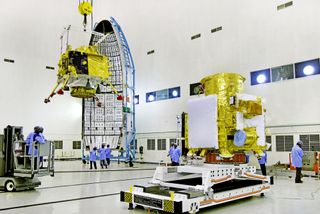
India's Vikram moon lander (left) is moved into launch position on the Chandrayaan-2 lunar orbiter ahead of a planned July 2019 launch. The mission will send an orbiter, lander and rover to the moon.
(Image credit: India Space Research Organisation)
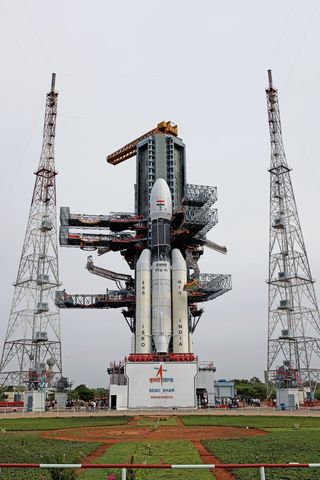
A GSLV Mark III rocket carrying the Chandrayaan-2 moon orbiter, lander and rover stand ready to launch from India's the Satish Dhawan Space Centre in Sriharikota.
(Image credit: India Space Research Organisation)
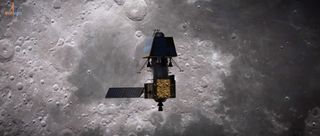
An artist's illustration of India's Chandrayaan-2 orbiter (bottom) and the Vikram lander, which carries the Pragyan rover, in orbit around the moon.
(Image credit: Indian Space Research Organisation)

The target landing site for India's Chandrayaan-2 mission to explore the lunar south pole.
(Image credit: Indian Space Research Organisation)
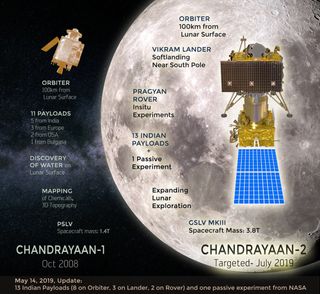
A breakdown of India's Chandrayaan-2 moon mission.
(Image credit: ISRO via Twitter)
Chandrayaan-2 will build on the work of its predecessor orbital mission Chandrayaan-1, which is most famous for helping to discover molecules of water on the moon a decade ago. The mission costs a relatively low $140 million, according to the Times of India.
Coincidentally, Chandrayaan-2 is also launching just days before the 50th anniversary of the first human moon landing — Apollo 11 — on July 20.
Here's what the new orbiter, lander and rover will do.
Mission profile

India plans to launch its second moon mission, Chandrayaan-2, in July 2019.
(Image credit: Indian Space Research Organisation)
Let's start with the spacecraft's rocket, which is called the Geosynchronous Satellite Launch Vehicle Mark-III. This is a three-stage vehicle billed as India's most powerful launcher. According to the Indian Space Research Organisation (ISRO), the rocket will launch and eventually place the spacecraft into what's called an Earth parking orbit. This is a stable circle around the planet that allows mission controllers to check in on the spacecraft orbiter and attached lander, and make sure all is well.
From there, Chandrayaan-2 will be placed on a lunar transfer trajectory — its path to the moon.
The spacecraft will fire its engines once more at the vicinity of the moon to insert itself into lunar orbit, then gradually circle closer and closer until it achieves a circular orbit of an altitude of 62 miles (100 kilometers) above the moon. Then it will be time for the 5,200-lb. (2,400 kilograms) orbiter and 3,200-lb. (1,500 kg) lander to start their separate missions.
"On the day of landing, the lander will separate from the orbiter and then perform a series of complex maneuvers," ISRO stated.
The lander is called Vikram, after India's space program founder Vikram Sarabhai, according to The Planetary Society. After getting into the right trajectory, Vikram will touch down between two craters called Manzinus C and Simpelius N, about 70 degrees south of the equator.
Vikram's next act will be deploying a 60-lb. (27 kg) rover, called Pragyan ("wisdom" in Sanskrit). Pragyan is designed to travel for up to 0.3 miles (0.5 kilometers) and to last for about one lunar day, which is equivalent to 14 Earth days.
The rover will send back its science data to Vikram, which can communicate either to the orbiting spacecraft, or directly to the Indian Deep Space Network, the society added. Even after the rover ceases operations, the orbiter is expected to keep working for roughly a year.
Science instruments
Chandrayaan-2 will bring forward the science performed by Chandrayaan-1 a decade ago. ISRO said it wants to gain more information on the moon's origin story and evolution by examining the moon's topography, mineralogy and more.
"We will also explore discoveries made by Chandrayaan-1, such as the presence of water molecules on the moon and new rock types with unique chemical composition," ISRO officials said.
The following instrument descriptions are based off of information from its website.
The orbiter is equipped with two cameras — a terrain mapping camera and an orbiter high resolution camera (OHRC) — to give detailed maps of the surface. OHRC will also help Vikram arrive safely by looking for craters or boulders before the lander separates.
Information about the moon's composition will come through a pair of spectrometers: the Large Area Soft X-ray Spectrometer (CLASS) and an infrared spectrometer. A synthetic aperture radar will scan for water ice and also estimate the thickness of the soil (regolith). The orbiter also has instruments to look at solar X-rays and the moon's tenuous atmosphere (or exosphere).
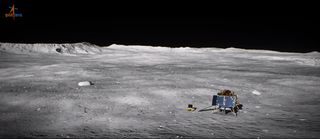
An artist's illustration of India's Chandrayaan-2 lander, Vikram, and its Pragyan rover on the surface of the moon near the lunar south pole.
(Image credit: Indian Space Research Organisation)
The Vikram lander has three main instruments on board.
- The Radio Anatomy of Moon Bound Hypersensitive ionosphere and Atmosphere (RAMBHA) instrument will look at the temperature density of electrons near the lunar surface. The instrument will also examine how plasma, or superheated gas, changes near the lunar surface under different solar conditions.
- Chandra's Surface Thermo-physical Experiment (CHASTE) looks in detail at the lunar surface. It will be learning about how the temperature varies by depth, and how well the surface conducts heat. It includes a thermal probe (sensors and a heater) that will be placed into the regolith as far as 4 inches (10 centimeters) deep.
- The Instrument for Lunar Seismic Activity (ILSA) will listen for moonquakes. The seismometer is designed to "detect minute ground displacement, velocity or acceleration caused by lunar quakes", according to ISRO.
The Pragyan rover, meanwhile, will have two instruments of its own.
- An Alpha Particle X-Ray Spectrometer (APXS) will learn about the elemental composition of the moon around the landing site. The instrument bombards the surface with X-rays (or alpha particles) and then examines the result. This will allow the instrument to identify elements known to make up rocks on the moon, such as sodium, magnesium and aluminum. It can also pick up trace elements such as strontium or zirconium.
- A Laser Induced Breakdown Spectroscope (LIBS) will also hunt for elements, but more by abundance. "It does this by firing high-powered laser pulses at various locations and analyzing the radiation emitted by the decaying plasma," ISRO said.
The mission also includes a small NASA laser retroreflector array "to understand the dynamics of Earth's moon system, and also derive clues on the lunar interior," ISRO stated. Like some Apollo and Lunokhod missions that landed on the moon in past decades, this array will allow scientists to fire lasers from Earth at a reflector, which will bounce the signal back to Earth. They will then derive scientific data from measuring the dispersion (spreading) of the laser upon its return, as well as how long the laser takes to return.
Visit Space.com Sunday, July 14, at 5 p.m. EDT (2100 GMT/0230 July 15 IST) for a live launch webcast of India's Chandrayaan-2 mission. You can watch it live here on Space.com and directly from ISRO here.
Follow Elizabeth Howell on Twitter @howellspace. Follow us on Twitter @Spacedotcom and on Facebook.
Bagikan Berita Ini














0 Response to "The Science of India's Chandrayaan-2 Mission to the Moon's South Pole - Space.com"
Post a Comment